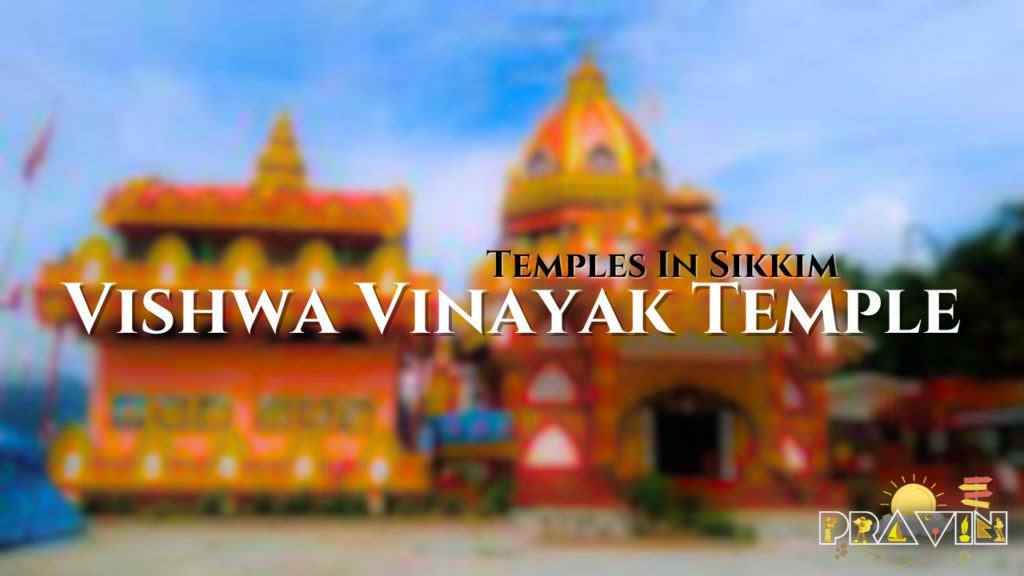Vishwa Vinayak Temple in Sikkim is one of the many hidden gems the state has. This magnificent temple dedicated to Lord Ganesha stands as a testament to the devotion and craftsmanship of the region. On my previous visit to Sikkim, I had to visit this remarkable temple that the locals of Sikkim had told me about.
In this blog, I share my experience of the time I visited the Vishwa Vinayak Temple in Sikkim and all the stories that I have heard about the place.
Vishwa Vinayak Temple
When I first arrived at the Vishwa Vinayak Temple in Sikkim, I felt like I had stumbled upon something truly special. The temple is tucked away in the beautiful hills of Sikkim, and getting there felt like a journey in itself. The winding roads, the crisp mountain air—it all led up to this serene spot where the temple stands, almost as if it’s been gently placed there by nature.
As I walked up to the temple, the first thing that caught my eye was the golden spire shining brightly against the green of the mountains. It was one of those moments where you just have to pause and take it all in. There’s something about the way the temple blends with its surroundings that makes it feel like a natural part of the landscape, rather than something man-made.
Inside, the temple was just as captivating. The idol of Lord Ganesha was beautiful, and I could feel a sense of calm just standing there. It wasn’t just about the rituals or the prayers—it was about the atmosphere, the quiet, and the connection to something larger than myself.
What I loved most was how the temple seemed to bring everyone together, whether it was locals who came regularly or travelers like me who were just passing through. I remember sitting on the temple steps, looking out at the breathtaking view of the hills, and feeling completely at peace.
Location Of Vishwa Vinayak Temple
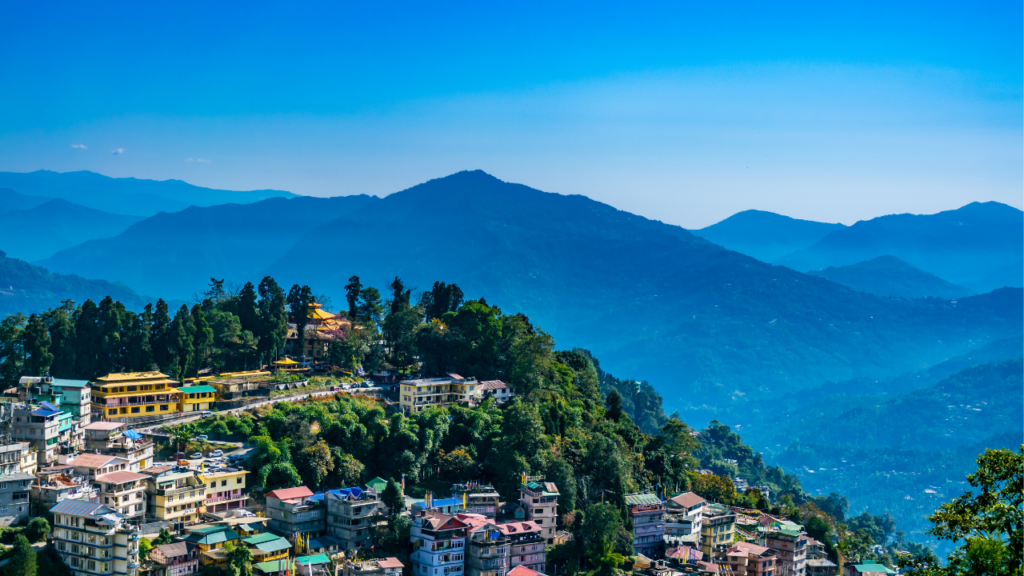
The Vishwa Vinayak Temple is located in the village of Rhenock, East Sikkim. Rhenock is about 63 kilometers from Gangtok, the capital city of Sikkim. The temple is built on a hilltop, offering breathtaking views of the surrounding valleys and the distant hills. This temple in Rhenock is visited by people from all across the state in large numbers.
How To Reach Vishwa Vinayak Temple
If you are planning on going to Vishwa Vinayak Temple, you have to reach Rhenock. Rhenock is accessible by road and can be reached from various parts of Sikkim. The most convenient way to reach Rhenock is to first come to Gangtok and then hire a private taxi or take a shared cab to Rhenock. The distance from Gangtok to Rhenock is approximately 63 kilometers. You can also use the state buses to reach Rhenock and then finally travel to Vishwa Vinayak Temple.
What Is The Main Attraction Of Vishwa Vinayak Temple?
If you are traveling to Sikkim, mark your dates and do not miss an opportunity to visit the temple during Ganesh Chaturthi. You are guaranteed to get a different experience during this time of the year. The festival of Ganesh Chaturthi in this temple in Rhenock is the main attraction of the temple.
The temple is not only a place of worship but also a marvel of architecture and spirituality. The beautiful idol of Lord Ganesha, the serene environment, and the panoramic views make it a perfect place to find peace and tranquility.
Vishwa Vinayak Temple Architecture
Here’s an overview of the architecture and features of the Vishwa Vinayak Temple:
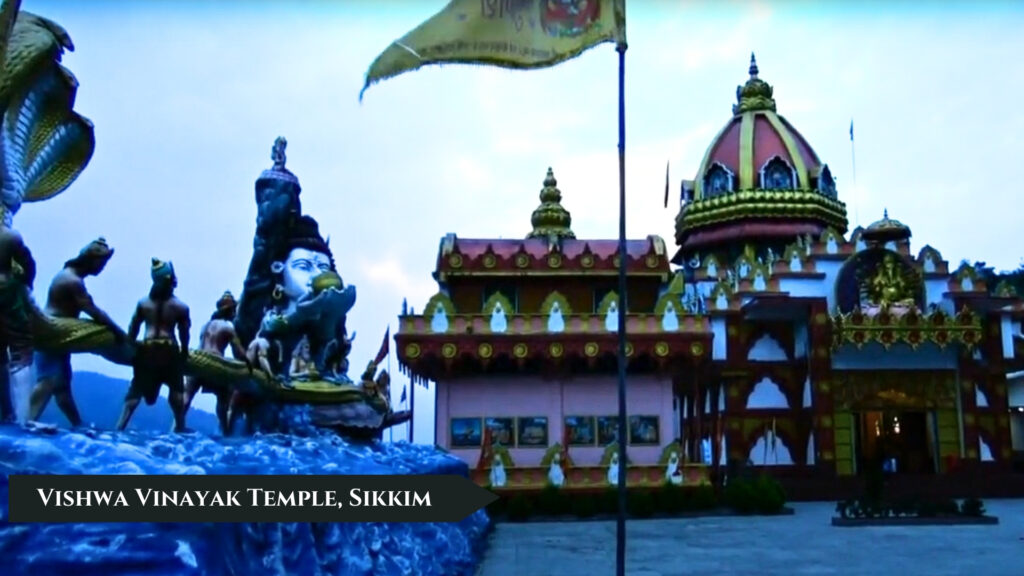
Architectural Style
- Himalayan Influence: The architecture of temple showcases a blend of traditional Himalayan styles, reflecting the local culture and religious practices.
- Colorful Facade: The temple is adorned with vibrant colors, making it a visually appealing spot. The use of red, yellow, and green hues adds to the temple’s charm.
Structural Elements
- Main Shrine: The main sanctum houses a large and beautifully crafted idol of Lord Ganesha. The sanctum is simple yet elegant, focusing on the deity’s presence rather than elaborate decorations.
- Mandap (Hall): The temple has a spacious mandap or prayer hall where devotees gather for rituals and ceremonies. This area is typically open and airy, facilitating the flow of air and light.
- Entrance and Courtyard: The temple features a grand entrance leading into a courtyard, where various smaller shrines dedicated to other deities might be located. These courtyards are often used for community gatherings and festivals.
Decorative Elements
- Intricate Carvings: The temple walls and pillars are adorned with intricate carvings and motifs depicting various aspects of Hindu mythology, particularly scenes related to Lord Ganesha.
- Sculptures: Statues and sculptures of different deities, mythological figures, and animals are placed around the temple premises, adding to its spiritual ambiance.
- Prayer Flags: Reflecting the syncretism of Hindu and Buddhist practices in the region, the temple surroundings often feature colorful prayer flags that are commonly seen in Himalayan religious sites.
Vishwa Vinayak Temple Information
The Vishwa Vinayak Temple holds significant spiritual value for the locals and is a popular destination for tourists seeking peace and tranquility. The temple is not only a place of worship but also a spot to appreciate the natural beauty of Sikkim.
Best Time To Visit Vishwa Vinayak Temple
As mentioned above, Ganesh Chaturthi is a major event of the Vishwa Vinayak Temple. I, thus, feel that the months of August – September are the best time to visit the temple. The place will be decorated beautifully during this time of the year.
The later part of the month of February and the beginning of March would be another great time to visit the temple because of the pleasant weather. The serene environment during these months makes it an ideal time to visit.
Vishwa Vinayak Temple History and Local Beliefs
According to local beliefs, the temple is a sacred spot where people come to seek blessings from Lord Ganesha for prosperity and good fortune. The temple’s history is rooted in the spiritual traditions of the region, and it is considered a powerful place for prayer and meditation.
The locals believe that offering prayers at Vishwa Vinayak Temple helps in removing obstacles and bringing good luck. The temple is also associated with various local legends and stories that add to its mystical charm.
Summing Up My Trip To Vishwa Vinayak Temple
Visiting the Vishwa Vinayak Temple in Sikkim was more than just a stop on my trip; it was an experience that stayed with me. It’s a place where you can find a moment of quiet reflection, surrounded by the beauty of nature, and leave feeling refreshed and connected. Whether you’re deeply spiritual or just looking for a peaceful retreat, this temple offers something truly special.
My trip to the Vishwa Vinayak Temple in Sikkim was nothing short of magical. The journey itself was an adventure, with winding roads that took me through the breathtaking hills of Sikkim. When I finally arrived, the temple felt like a hidden treasure, perfectly situated among the lush greenery.
Other Temples In Sikkim
Here below, I have added some other famous temples in Sikkim that you can look forward to visiting. I have a blog dedicated to famous temples in Sikkim that covers almost all the temples of the state.
Ganesh Tok

Ganesh Tok is a small but significant temple dedicated to Lord Ganesh. Offering panoramic views of Gangtok and the surrounding mountains, this temple is a peaceful spot for devotees and tourists to seek blessings and enjoy the natural beauty of Sikkim.
Hanuman Tok

Situated in rich forests, Hanuman Tok is a reputed temple dedicated to Lord Hanuman. Visitors can climb the stairs to the temple and marvel at the amazing vistas of Gangtok and the Himalayas, making it a popular destination for spiritual seekers and nature enthusiasts alike.
Baba Harbhajan Mandir

Baba Harbhajan Mandir is a unique temple dedicated to an Indian army soldier, Baba Harbhajan Singh. Believed to protect and bless the soldiers guarding the Indo-China border, this temple attracts devotees who come to pay homage to the spirit of the reputed soldier and seek his blessings for protection and well-being. Baba Harbhajan Mandir is situated in the East Sikkim region of the state of Sikkim.
Thakurbari Temple
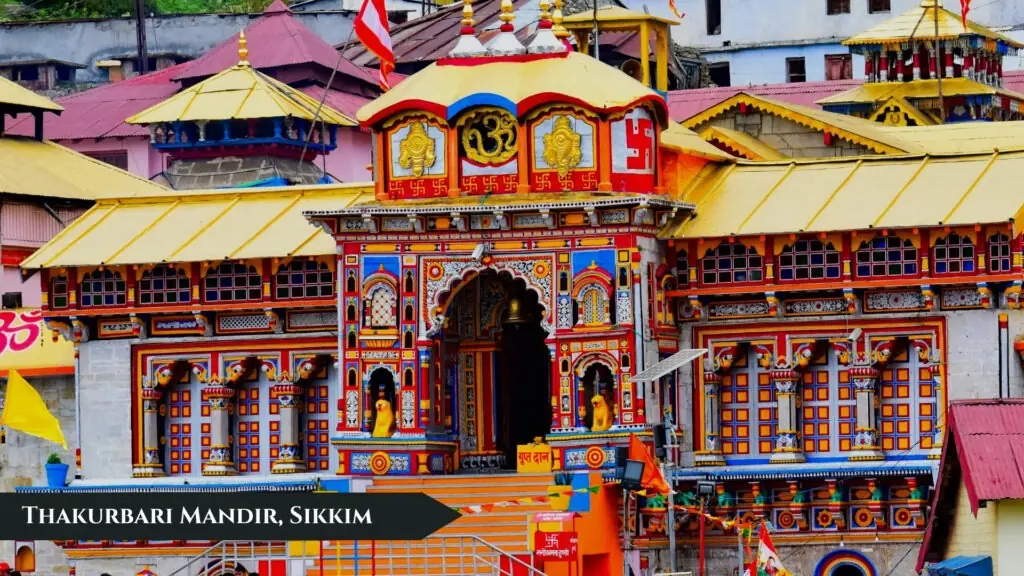
Thakurbari Temple is a prominent Hindu temple in Sikkim dedicated to Lord Krishna. Known for its beautiful architecture and peaceful surroundings, the temple is a place of worship and pilgrimage for devotees from across the state and beyond.
Kirateshwar Temple
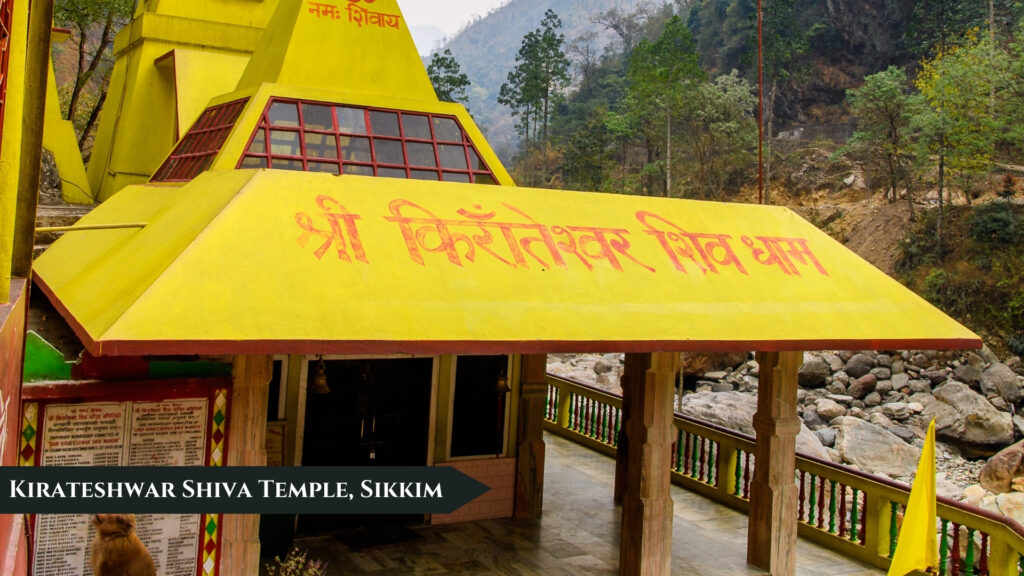
Kirateshwar Temple is dedicated to Lord Shiva and is believed to be the spot where Arjuna, from the Mahabharata, received the divine weapon, Pashupatastra. Surrounded by rich greenery and overlooking the confluence of two rivers, this temple holds great religious significance and attracts devotees seeking blessings and solace.
Samdruptse Temple
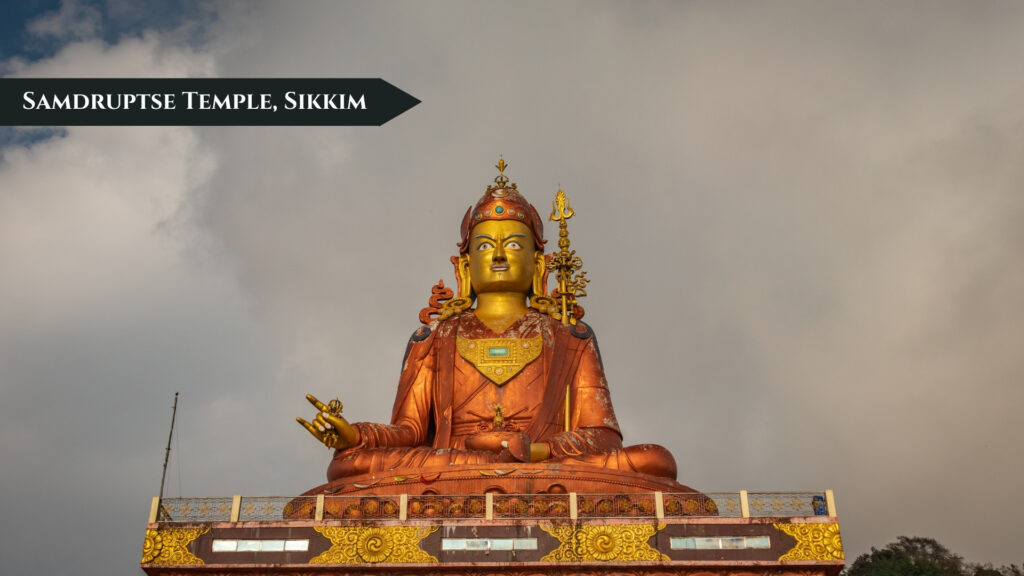
Samdruptse Temple is home to the high statue of Guru Padmasambhava, also known as Guru Rinpoche, who is reputed as the patron saint of Sikkim. Perched on top of a hill, the temple offers panoramic views of the Himalayas and serves as a spiritual beacon for devotees and visitors alike.
Frequently Asked Questions Related To Vishwa Vinayak Temple
Below are some of the frequently asked questions related to the Vishwa Vinayak Temple that you need to take a loot at if you are planning on visiting Sikkim and exploring the temples of Sikkim:
What is the significance of Vishwa Vinayak Temple?
The temple is a significant Hindu shrine dedicated to Lord Ganesha, known for its spiritual ambiance and panoramic views. Beyond its religious importance, the temple is also a retreat for those seeking peace and a connection with nature. Situated in the serene hills of Sikkim, the temple offers breathtaking views and a tranquil environment that enhances the spiritual experience.
It’s a place where visitors, whether spiritual seekers or tourists, can find a moment of calm amidst the beauty of the natural surroundings. The Vishwa Vinayak Temple stands as a testament to the harmonious blend of spirituality, culture, and nature, making it a must-visit destination in Sikkim.
Where is Vishwa Vinayak Temple located?
The Vishwa Vinayak Temple is situated near Rhenock, a charming town in East Sikkim, and it feels like a hidden treasure. As I approached, the journey was just as captivating as the destination—winding roads lined with lush greenery and stunning views of the mountains. Each turn revealed more beauty, making me excited to see what was ahead. When I finally arrived, the temple stood gracefully amid the hills, inviting me in with its peaceful aura.
Inside, I was immediately struck by the calmness that enveloped the place. It was a perfect spot to take a moment for myself, away from the noise of everyday life. I remember sitting on the steps, breathing in the fresh mountain air and soaking in the view of the rolling hills. Whether I was there to pray or just to appreciate the tranquility, the temple offered a unique connection to both nature and my own thoughts. Visiting the Vishwa Vinayak Temple was more than just a stop on my trip; it was a memorable experience that left me feeling refreshed and inspired.
What is the best time to visit Vishwa Vinayak Temple?
The best time to visit is during Ganesh Chaturthi in August – September and during the pleasant weather months of February to March.
How can one reach Vishwa Vinayak Temple?
The temple can be reached via road from Gangtok. The nearest airport is Bagdogra in West Bengal, from where you can take a taxi to Gangtok and then proceed to Rhenock.
Is there an entry fee for Vishwa Vinayak Temple?
No, there is no entry fee for visiting the temple.
What facilities are available for visitors at Vishwa Vinayak Temple?
Basic facilities such as restrooms, drinking water, and a resting area are available. Additionally, nearby shops and eateries provide refreshments and religious offerings.
Are there any special rituals performed at Vishwa Vinayak Temple?
Daily pujas and aartis are conducted, and special rituals are performed during Ganesh Chaturthi and other festivals dedicated to Lord Ganesha.
Is photography allowed inside Vishwa Vinayak Temple?
Photography is generally allowed in the temple premises, but it’s advisable to check with the temple authorities regarding any specific restrictions.

